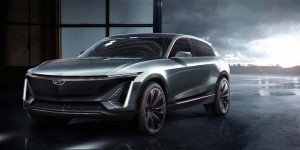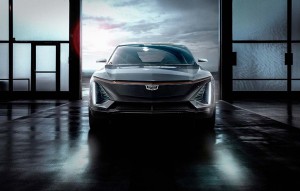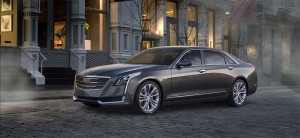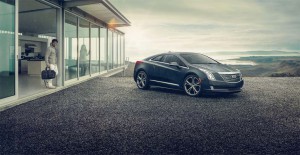
Cadillac retook its position as General Motor's innovative brand with the reveal of its first EV off a new flexible platform. The finished CUV arrives in 2020.
Cadillac will become the first brand to use the all-new battery-electric vehicle architecture parent General Motors is developing, with its first all-electric model, a midsize crossover, scheduled to come to market in late 2020 or early 2021.
The new, skateboard-like platform will have significant flexibility, said Cadillac President Steve Carlisle during a media event marking the start of the 2019 North American International Auto Show. It eventually will allow Caddy and its sibling GM brands to produce a wide range of sizes, shapes and drivetrain layouts as the automaker begins to shift away from conventional gas and diesel-powered vehicles.
The new platform, said Carlisle, “can build literally everything in the portfolio,” including vehicles that are front-, rear- or all-wheel-drive. And by varying the number of batteries in the pack hidden under the vehicle load floor, GM can offer varying ranges while pricing for different segments of the market.
GM CEO Mary Barra has said that the automaker wants to ultimately abandon the internal combustion engine, though she has not yet laid out a formal, public timetable. The decision to put Cadillac at the lead reflects its traditional role as the corporate innovator.
(Cadillac reshapes line-up with new CT6 crossover. Click Here for the story.)

Cadillac's new midsize crossover EV is just the first of many new battery electrics coming for the brand.
“Taking the lead in innovation and technology will make Cadillac Cadillac again,” Barra told reporters gathered at the event.
Whether the luxury brand can be seen as taking a lead in electrification is a matter of perspective, however. It failed in its first effort to launch a plug-in hybrid, the ELR, which was based on the Chevrolet Volt. Last November, it pulled the plug on a second PHEV, a version of the CT6 sedan which will go entirely out of production this year.
Meanwhile, an assortment of competitors are already pushing into the long-range battery-electric space, including luxury competitors Audi and Mercedes-Benz, both of which will have new BEVs in showrooms before the end of the year.
While GM officials declined to provide a hard date for the launch of the Caddy electric utility vehicle, Carlisle told TheDetroitBureau.com it will come be sometime “2020-ish,” which suggests that could push into 2021.
Nonetheless, adding the new model certainly should help Cadillac in its struggle to regain its once lofty position among luxury brands, said Stephanie Brinley, principal automotive analyst with IHS Markit. “I think it’s a good move for Cadillac to be the catalyst,” she said, though Brinley questioned whether it will be “enough to move the needle for the brand.”
The flexible platform upon which Caddy’s electric SUV will be based could handle essentially everything the brand – and the rest of GM – might eventually want to offer with a battery-drive system, from small cars to big SUVs, though it’s unclear if the automaker might eventually use the architecture for its pickups, as well.
(Click Here for a review of the Cadillac XT4.)
The modular approach not only allows the carmaker to adjust the number of battery cells in its pack but to adjust the length, width and even the ride height of the platform.

Cadillac's already had an electric crossover: the CT6 plug-in electric hybrid, which was produced in China.
While Cadillac will continue to use familiar visual cues from its Art & Science design language for the new battery-electric vehicle – such as the brand’s distinctive vertical head and taillights – there’ll be some significant changes, as well.
Digital renderings shown during the presentation suggest the BEV crossover will have a more cab-forward layout, no surprise considering the batteries and motors will be mounted under the load floor, rather than in a traditional engine compartment. In turn, that will allow a much larger cabin than the exterior footprint might suggest, explained Andrew Smith, Cadillac’s chief designer.
“It allows the design team to redefine the proportions, and the face of Cadillac,” he said, noting that without an air-gulping gas or diesel engine, the vehicle also won’t need a big grille. “Electrification gives a designer a chance to ask what goes where.”
By various estimates, the auto industry will spend as much as $200 billion – or more – by mid-decade in the push to electrify. Analysts like Brinley caution that this is a big risk considering that all forms of battery-based vehicles, from conventional hybrids to pure BEVs, accounted for barely 5% of the new vehicle market last year. The Detroit-based consultancy AlixPartners warned in a recent study this could lead to “a pile-up of epic proportions.”
(To see more about GM’s bigger expectations for 2019, Click Here.)
But there are signs that the technology finally may be gaining traction. Tesla sold about as many vehicles in 2018 as it did in all preceding years. And China, now the world’s largest market for plug-based vehicles, recorded massive growth in 2018, driven by new emissions standards. Barring a sharp rollback in U.S. mileage standards by the Trump Administration – a move that now seems stalled – automakers are expected to greatly increase their dependence upon electrification.

